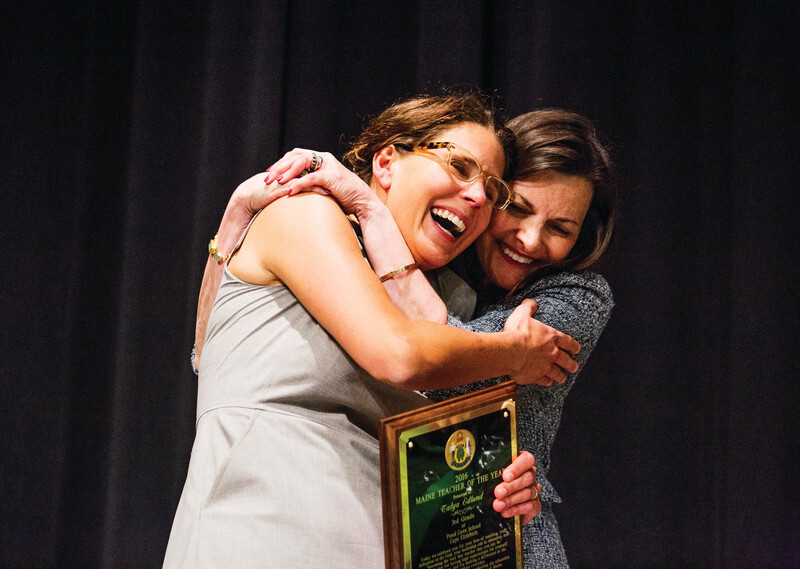March 1, 2016
•
5 min (est.)•
Vol. 73•
No. 6Principal Connection / Multiple Ways to Learn
Credit: Copyright - 2015 Portland Press Herald
How important is it that every student in a school is excited about learning? Should we allow a student to use all her strengths in learning? Do you know someone who wasn't a particularly good student but has been very successful in life?
What these seemingly unrelated questions have in common is an appreciation for the range of talents that students—that all of us, really—possess. Answering them leads us to the theory of multiple intelligences (MI) conceived by Howard Gardner. My school began implementing MI in 1988. MI was not a panacea, but our school was filled with students and teachers who were excited about learning. And over the next decade-plus, hundreds of educators visited us each year to see how they could use MI to help more children learn and to help children learn more.
Then in 2001, No Child Left Behind was passed, and it became harder for teachers and principals to use multiple intelligences. Students' skills in the three Rs, determined by scores on standardized tests, became the measure of teacher and principal effectiveness. Educators knew the scores weren't all that mattered, but they also knew scores were what mattered most. In 2009, Race to the Top widened the path—but not by much.
The recent passage of the Every Student Succeeds Act (ESSA) appears to be a step in the right direction. The White House notes that
<BQ> the bill encourages a smarter approach to testing by moving away from a sole focus on standardized tests to drive decisions around the quality of schools, and by allowing for the use of multiple measures of student learning and progress, along with other indicators of student success to make school accountability decisions. </BQ>
I'm encouraged by ESSA, but I'm also hesitant. "Multiple measures" sounds good, but it will be hard to back away from the ease and objectivity of standardized measures. Failing to do so would be our loss—and a loss for our students.
Intelligence is problem solving, and many problems are best solved by using a combination of intelligences. In schools, we typically limit students to using the scholastic intelligences—linguistic and logical-mathematical. Employing the musical, bodily-kinesthetic, spatial, naturalist, intrapersonal, or interpersonal intelligences isn't encouraged as an option. That's unfortunate because these nonscholastic intelligences are integral to solving many of the problems we face every day.
Communication in the real world travels through many intelligences. The written word is only one way to describe events or relay messages. Often messages come to us through music, art, animation, or artifacts—so why not enable students to use these intelligences to share what they've learned?
At my school, for example, students read about the U.S. Civil War. But they also watch videos, access museum websites, touch artifacts, and visit nearby relevant locations. And although they take tests and write reports, they also build dioramas, draw timelines, develop plays with characters presenting differing points of view, and create poems or music that capture the times and tensions of that era.
Likewise, in studying citizens who have made a difference in their community or the world, our students read about and write biographies of famous people. But they also use other intelligences for learning and sharing their knowledge. During Living Museum Day, they make presentations while dressed in costumes they created. Students from other classes, parents, and educators come to the "museum" (our library) to hear the oral presentations and then ask questions of Rosa Parks, John F. Kennedy, Michelangelo, or Mia Hamm. Preparing to present in the museum requires students to do research, write a report, make a costume, create an artifact, give an oral presentation, and respond to audience questions. No child fails at the Living Museum. Every student is excited about learning and uses different intelligences to show what he or she has learned.
We value all intelligences at New City School, but we give a special focus to the personal intelligences because we believe that who you are is more important than what you know. The first page of every student's report card focuses solely on the personal intelligences—interpersonal (understanding others) and intrapersonal (knowing yourself). That emphasis is also reflected throughout our curriculum. Teachers are always on the lookout for ways to help children develop kindness, an appreciation for others, and grit.
My fingers are crossed that ESSA will allow us to return to using multiple intelligences to help students learn. How could you help your teachers use MI to increase student learning?
End Notes
•1 Gardner, H. (1983). Frames of mind. New York: Basic Books.
•2 Muñoz, C. (2015, December 7). Q&A: What you need to know about the fix to No Child Left Behind [blog post]. Retrieved from The White House Blog.
•



